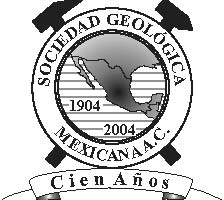|
BOLETÍN DE LA SOCIEDAD GEOLÓGICA MEXICANA VOL. 59, NÚM: 1, 2007, p. 43-62 http://dx.doi.org/10.18268/BSGM2007v59n1a4 |
 |
Estratigrafía del Noreste de México y su relación con los yacimientos estratoligados de fluorita, barita, celestina y Zn-Pb
Francisco González Sánchez1,2,*, Rafael Puente Solís1,2, Eduardo González Partida2, Antoni Camprubí2,3
1 Posgrado en Ciencias de la Tierra, Universidad Nacional Autónoma de México.
Ciudad Universitaria, Delegación Coyoacán, 04510 México, D.F., México.
2 Centro de Geociencias, Universidad Nacional Autónoma de México.
Campus Juriquilla, Carretera Querétaro-San Luís Potosí km 15.5, Apartado Postal 1-742, 76230 Santiago de Querétaro, Qro., México.
3 Dirección actual: Instituto de Geofísica, Universidad Nacional Autónoma de México.
Ciudad Universitaria, Delegación Coyoacán, 04510 México, D.F., México.
* This email address is being protected from spambots. You need JavaScript enabled to view it.
Abstract
In Northeastern Mexico, basically the states of Coahuila and Nuevo León, over 200 known stratabound celestine, barite, fluorite, and Pb-Zn deposits are found, with geological characteristics that allow assigning them to the Mississippi Valley type (MVT) and similar deposits. These deposits occur in different sedimentary formations in the Mesozoic Sabinas Basin since the beginning of the Laramide Orogeny. This basin was bounded by several horsts (i. e. the Coahuila Block) that were important paleogeographic highs during the Mesozoic and ruled the sedimentation of several detritic formations in their vicinities. In order to characterize the formation of MVT in this area we first describe the stratigraphy of the Sabinas Basin, from the first marine transgression during the Callovian, and the subsequent regressions and transgressions during the Upper Jurassic until the Upper Cretaceous (Campanian-Maastrichtian), when the Laramide Orogeny changed the depositional regimes in the region. Our analysis on the space and time distribution of the MVT deposits in Northeastern illustrates the close relationship between the occurrence of such deposits and specific stratigraphic sequences, especially those that contain evaporites and carbonate rocks formed in shallow lagoonal environments. Likewise, we determined the dominance of celestine deposits in rocks overlying the Permian-Triassic granitic basement, and that most of the fluorite deposits are found in neighboring areas to the metasedimentary basement, also aged Permian-Triassic. The distribution and grouping of the different mineralizations allow to set limits to a newly proposed metallogenic province, named “MVT Province of Northeastern Mexico” or MPNM, thus subdivided into four subprovinces, (1) Southern Celestine Subprovince, (2) Central Lead-Zinc Subprovince, (3) Central Barite Subprovince, and (4) Northern Fluorite Subprovince. We also suggest that the Sr and Ba in celestine and barite deposits were leached from clastic formations whose source areas are Permian-Triassic granitic rocks in the basement highs on the borders of the Sabinas Basin. Thus, most Sr would be radiogenic and would have been leached from clastic formations in the vicinities of basement highs, and the formation of stratabound deposits would be due to the interaction of basinal brines (whose flow would have been activated by the Laramide orogeny) with stratigraphic horizons favorable to their circulation. Such hypotheses are the startline to forthcoming geochemical studies to set a depositional model to stratabound deposits in the MPNM.
Keywords: MVT deposits, Sabinas Basin, Northeastern Mexico, Mesozoic stratigraphy, Laramide Orogeny, basinal brines.

